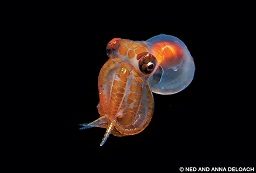Diving in the open sea at night is not new to us. Typically we travel well offshore where larval fishes and invertebrates spend the formative weeks of their lives after being spawned. These tiny orphans of the reef equipped with translucent bodies, oversized fins, spines and streamers are unlike anything we have ever seen. Unfortunately, because of logistics, dive operators are understandably reluctant to drop us far out in the ocean after dark. As an alternative, Anna suggests swimming from the beach to see if our lights will attract mature larvae ready to settle inshore. Why not? We’re in Bonaire, which is renowned for shore diving.
It is well past sunset when Anna and I wade into the sandy shallows and submerge. With our lights switched off we swim directly seaward, navigating over a wide sand shelf by the light of the rising moon. Crossing the interface where the sand gives way to a plunging coral slope, we snap on three video beams illuminating a black sea liberally pocked with distracting bits of detritus. We pause 20 feet below the surface and 40 feet above the bottom, staring into the emptiness for fleeting glimpses of larval fishes and invertebrates until our eyes cross.

These late-stage pelagic larvae we’re seeking are going through a radical transformation, losing much of their transparency and seafaring adaptations as they prepare for life on the seafloor. At the same time they have become proficient swimmers while at sea, with the ability to use smell, hearing and yet undeciphered cues to navigate toward inshore habitats, where they will spend the remainder of their lives. Shortly before heading for their new home, mature larvae get caught along frontal boundaries where water masses of different densities meet, forcing everything that swims or floats toward the surface. There the settlers wait along with a mob of transient zooplankton for the tide to carry them toward the shallows under the cover of darkness, when chances of predation are less. Dazed and defenseless, the new generation of reef fishes and bottom-dwelling invertebrates dive for cover or bury in the sand, emerging a day or so later transformed into competent, site-attached juveniles.
We are still squinting into the night 30 minutes later when the leading edge of a current begins pushing north. As the flow increases, a cloud of worms and tiny crustaceans arrives as if out of nowhere, storming our lights and darting into our ears. A scattering of larval animals follows. First on the scene are mantis shrimp, as delicate-looking as lace, disoriented and spinning crazily, followed by ribbon-thin bonefish larvae weaving through our lights. The dive’s results are not as dramatic as hoped, but from our experience night drifting offshore, we are well aware that this is a hit-and-miss game of chance we are playing.

Attempting to improve our odds, we check a local tide chart and find that the next evening’s high tide is not until midnight, long past our bedtime. But we decide to give it a go, hunting inside a halo of lights above the dropoff until past 1 a.m. without seeing much of interest. Abandoning the chart, we slip into the ocean the next evening at the reasonable hour of 8 p.m. only to find ourselves swimming against a southbound current. Just as we are thinking of calling it quits, the first flurry of crustaceans appears accompanied by a splendid red trumpetfish only 2 inches long, then a pea-sized puffer, followed by a blenny, a translucent lizardfish, a dozen quarter-sized surgeonfish, an assortment of crabs and shrimp galore.


A few months later we are back in the Caribbean, this time visiting Dominica and excited about the chance of going out to night light from the resort’s dock. But a week of pesky swells keeps us out of the water during the evenings. In frustration we hitch a ride on the night-diving boat headed for a shallow inshore patch reef. Instead of following the group, we position ourselves above the mooring block to monitor our position and switch on the lights. Within minutes we are inundated with minnows — hundreds, the size of your finger, going nuts in the lights, hitting us hard and often until we feel like paintball players in a losing cause. Adding to our aggravation, a swarm of crustaceans joins forces with the maddened minnows.
Once we discover that we can survive the onslaught, we bear up and begin looking for larvae. In the middle of it all Anna spots a spectacular longarm octopus with a see-through mantle the size of a jellybean. Somehow she gets my attention. Together we watch the lanky young cephalopod parachute down through the chaos, settle on the sand and promptly burrow beneath the surface of its new home.

Explore More
| © Alert Diver — Q1 2018 |
|---|
| © Alert Diver — Q1 2018 |